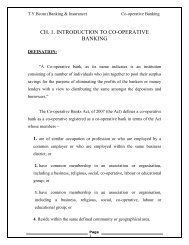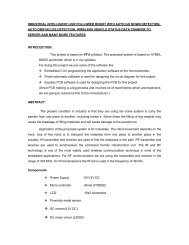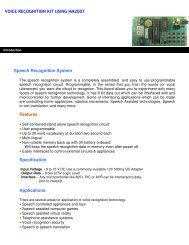Cloud Computing â âWhats the Buzz? - Ask, Find, Discuss about ...
Cloud Computing â âWhats the Buzz? - Ask, Find, Discuss about ...
Cloud Computing â âWhats the Buzz? - Ask, Find, Discuss about ...
- No tags were found...
You also want an ePaper? Increase the reach of your titles
YUMPU automatically turns print PDFs into web optimized ePapers that Google loves.
computing is one of <strong>the</strong> top two strategictechnologies in <strong>the</strong> year 2009 (Figure shownearlier). It also predicts that <strong>the</strong> impact ofcloud computing on IT vendors will be huge.Established vendors have a great presence intraditional software markets, and as newWeb 2.0 and cloud business models evolveand expand outside of consumer markets, agreat deal could change. Gartner predictsthat by 2012, 80 percent of Fortune 1000enterprises will be paying for some cloudcomputing services, and 30 percent will bepaying for cloud computing infrastructureservices.Here is an example of architectural changeswhich Gartner has predicted for <strong>the</strong> nextcouple of years.Phase 1: Monolithic (Early)Early cloud computing serviceswill be based on proprietary orinternal architectures – islandsof cloud services delivered by megaproviders. This is what Google, Salesforce andMicrosoft look like today.Phase 2: Vertical Supply Chain (2+ Years):Over time, some cloudproviders will leverage cloudservices from o<strong>the</strong>r providers(for example, ISVs moving intoSaaS on top of Microsoft’s Azure ServicesPlatform, use of Force.com, use of GoogleApp Engine). Still proprietary islands, butecosystems are starting to build.Phase 3: Horizontal Federation (4+ Years):Smaller providers willfederate horizontally togain economies of scale(and efficient use of assets) – also,enterprises will leverage horizontalfederation for peak capacity (overdraftprotection, cloud bursting). There will bemore choices at each layer of cloudcomputing, and standards will gainmomentum. Again, this is very similar to <strong>the</strong>development of <strong>the</strong> overall server market.Survey Conducted by Hosting.comA survey was conducted by Hosting.comrecently on <strong>the</strong> <strong>Cloud</strong> <strong>Computing</strong> Trends. Thesurvey was conducted across variousindustries such as Financial Services, Retail,Social Networking, Healthcare,Manufacturing, IT Service Providers,Marketing and Advertising, Non Profits andCity Governments. 69% of <strong>the</strong> organizationssurveyed had fewer than 100 employees,20% had greater than 100 but less than 1,000employees and 11% had greater than 1,000employees. The annual revenues of <strong>the</strong>organizations ranged from less than $1million to over $100 billion. The surveyprovided insight into <strong>the</strong> expectations small,medium and large businesses have of cloudcomputing, <strong>the</strong>ir intended uses, reasons foradopting and expected timeframes forimplementing cloud based solutions. Afteranalyzing <strong>the</strong> survey, <strong>the</strong> following pointscould be concluded:‐Two‐thirds of <strong>the</strong> respondents believe thancloud computing will have a major impact on<strong>the</strong> IT industry. However, 22% were familiarwith <strong>the</strong> term cloud computing but did notbelieve it would provide value to <strong>the</strong>ircompany. The larger companies view cloudcomputing more positively mainly due to<strong>the</strong>ir familiarity with cloud computingsolutions.The three most important factors drivingorganizations of all sizes to invest in cloudcomputing are Reduced Costs, Uptime andScalability. Similarly, <strong>the</strong> two least factorsdriving <strong>the</strong> organizations to invest in cloud15
















